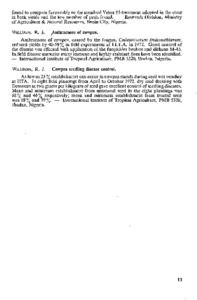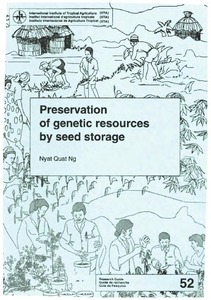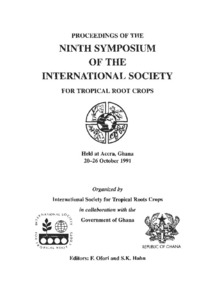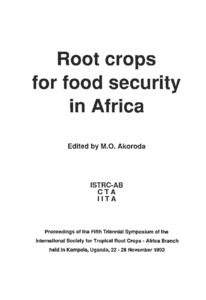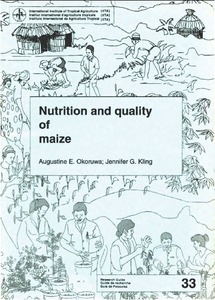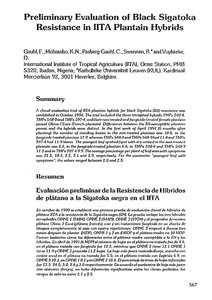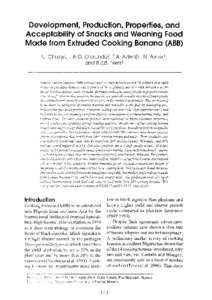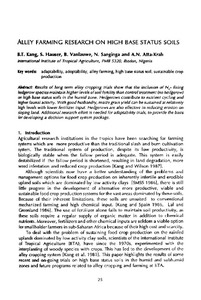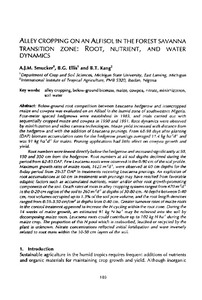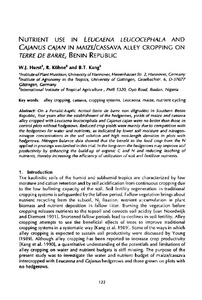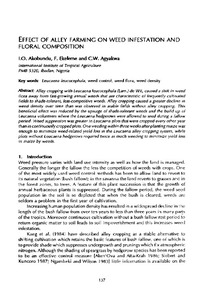Welcome to the International Institute of Tropical Agriculture Research Repository
Conference Documents: Recent submissions
Now showing items 541-560 of 726
-
Initial studies on the legume: rhizobium symbiosis
(1975-06)Twenty strains of cowpea Rhizobium have been screened to date for their ability to form nodules and to fix nitrogen using the Leonard jar assembly. The strains were tested on Ife Brown, TVu 1190, and TVx 222-01B. From among the twenty, four promising strains were selected. The nodulation and nitro-gen fixing ability of these strains plus Nitragin commercial inoculant on the three cowpea varieties were tested in two soils in the greenhouse. Many of the selected strains caused an increase in the ... -
Development of improved plantain/banana germplasm with black sigatoka resistance
(1994)Variety improvement of plantain and banana (Musa spp.) is based on genetic diversity, which provides the basis for selection gain. This paper reviews result obtained by the Plantain and Banana Improvement Programme (PBIP) of the International Institute of Tropical Agriculture in the development of improved plantain germplasm (TMPx) with stable yield, improved suckering, short stature and black sigatoka resistance. The success of this programme was basedon the significant genetic variability found ... -
Les facteurs determinant labondance du vecteur mouche blanche (Bemisia tabaci, Homoptera : Aleyrodidae) et les types des virus distribues sur le manioc en R.D. Congo
(2012-02)La mouche blanche (Bemisia tabaci) est le vecteur de la mosaïque et de la striure brune du manioc. Sa population a toujours été faible dans les champs de manioc. En plus, cet insecte trés polyphage, n'avait jamais constitué d'une manière directe, une menace réelle à la culture du manioc en Afrique. Depuis quelques années, cependant, on constate une pullulation de la mouche blanche sur le manioc. En plus du rôle lui réconnu comme vecteur des virus responsables de la CMD et de la CBSD, la mouche ... -
Alternative breads from cassava flour
(1994)New and alternative nutritious breads, can be produced from cassava flour fortified with 20% raw or roasted soy flour using locally available margarine with egg white, together or without xanthan gum. Margarine with egg white, increased control loaf volumes by 29%; the subsequent addition of xanthan increased oven rise and volumes by 35%. Margarine, and more significantly, egg white reduced the extent of starch gelatinization and solubilization in the bread, rendering them less gummy. Loaf volume ... -
Cassava in the production of bread and bakery products
(1994)A significant proportion of wheat flour can be replaced by cassava flour in the making of bread with little changes in the quality of bread. This paper shows that it is possible to make bread without using wheat flour. Soybean flour can also be mixed with cassava flour to increase the protein content of the baked products. Recipes for making breads, cakes an biscuits from cassava flour, and bread from cassava starch are presented. Sensory evaluation tests show that all baked cassava products are ... -
Preliminary results of screening IITA improved germplasm for resistance to Cassava Brown Streak Disease (CBSD) in Uganda
(2012-02)For quite some time, cassava breeding activities of the International Institute of Tropical Agriculture (IITA) in Uganda were mainly focused on developing genotypes resistant to cassava mosaic disease (CMD), which was the major biotic production constraint since the early 1990s. Although cassava brown streak disease (CBSD) was reported some time back in 1940s, it had been dormant in Uganda. However, in early 2004, cases of CBSD were reported and re-confirmed both onstation (Namulonge) and in ... -
Preliminary evaluation of black sigatoka resistance in IITA plantain hybrids
(1994)A clonal evaluation trial of llTA plantain hybrids for black Sigatoka (85, resistance was established in October 1990. The trial included the three tetraploid hybrids TMPx 5484. TMP" 548-9and TMP" 5974. and their non-treated and fungicide-treated female plantain parent Obino l'Ewa' (French plantain}. Differences between the BS-susceptible plantain parent and the hybrids were distinct. In the first week 01 April 1991 {6 months after printing' the number of standing leaves in the non-treated plantain ... -
IPMomics: from genomics to extension for integrated pest management of cowpea: Proceedings of the 5th World Cowpea Research Conference, held at Palm Beach Hotel, Saly, Senegal. 27 September 1 October
(2012)Insect pests often develop resistance to insecticides, and such resistance represents a serious management problem. Devising methods that concurrently delay resistance and minimize injury by insects to field crops and stored grain has long been a goal of Integrated Pest Management (IPM). A centerpiece of IPM has been the combined use of biological control agents and prudent application of chemical insecticides. Unfortunately, successful application of IPM has remained a challenge. This chapter ... -
Alley farming research on high base status soils
(1995)Result of long time alley cropping trials show that the inclusion of N2- fixing hedgerow species maintain higher levels of soil fertility than control treatment (no hedgerow) on high base status soils in the humid zone. Hedgerows contribute to nutrient cycling and higher faunal activity. With good husbandry, maize grain yield can be sustained al relatively high levels with lower fertilizer input. Hedgerows are also effective in reducing erosion on sloping land. Additional research effort is needed ... -
Improving the productivities of cowpeacereal systems in the savannas of West Africa through dissemination of improved varieties and cropping systems
(2012)Cowpea (Vigna unguiculata [L.] Walp.) is the most important grain legume in the dry savannas of West Africa, however grain and fodder yields are low (averaging 25 to 300 kg and 450 to 800 kg grain and fodder/ha, respectively) due to biotic and abiotic constraints. Improved varieties and cropping systems are continuously being developed to tackle the various constraints and some of the results have shown promises in limited on-farm trials in the past. Recently IITA, in collaboration with several ... -
Alley cropping on an Alfisol in the forest savanna transition zone: root, nutrient, and water dynamics
(1995)Below-ground root competition between Leucaena hedgerow and intercropped maize and cowpea was evaluated on an Alfisol in the humid zone of southwestern Nigeria. Four-meter spaced hedgerows were established in 1983, and trials carried out with sequentially cropped maize and cowpea in 1990 and 1991. Root dynamics were observed by minirhizotron and video camera technologies. Maize yield increased with distance from the hedgerow and with the addition of Leucaena prunings. From 68-98 days after planting ... -
Nutrient use in Leucaena leucocephala and cajanus cajan in maize/cassava alley cropping on Terre de barre, Benin Republic
(1995)On a Ferralic-haplic Acrisol (terre de barre non degradee) in Southern Benin Republic, four years after the establishment of the hedgerows, yields of maize and cassava alley cropped with Leucaena leucocephala and Cajanus cajan were no better than those in control plots without hedgerows. Reduced crop yields were mainly due to competition with the hedgerows for water and nutrients as Indicated by lower soil moisture and nitrogen-nitrogen concentration the soil solution and high root-Iength densities ... -
Analysis and interpretation of alley farming network data from tropical Africa
(1995)To date, the site-specific, mixed reports of the influence of hedgerows on crap yields provide little predictive insight into which type of tree/crop combination is most appropriate for a specific location. The Alley Farming Network for Tropical Africa was established in 1989. The objectives of that network include the identification of the best hedgerow species and management practices for tropical Africa. The results of the first 3 years of network activities were assembled into a statistical ... -
Effect of alley farming on weed infestation and floral composition
(1995)Alley cropping with Leucaena leucocephala (Lam.) de Wit, caused a shift in weed flora away from fast-growing annual weeds that are characteristic of frequently cultivated fields to shade-tolerant, less-competitive weeds. Alley cropping caused a greater decline in weed density over lime than was observed in arable fields without alley cropping. This beneficial effect was reduced by the upsurge of shade-tolerant weeds and the build up of Leucaena volunteers where the Leucaena hedgerows were allowed ...



